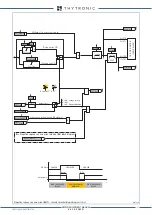
120
FUNCTION CHARACTERISTICS
—
Loss of field - 40
Application
Protection of synchronous generators and motors.
Preface
The loss of field for a synchronous motor or generator can have several causes: excitation faults,
power faults, field breaker open, brush fault, short-circuits or interruption of field winding.
Generator
Various causes might result in a synchronous generator losing excitation: faults with the exciter or
its supply system, unwanted opening of the field breaker, interruption or short-circuiting of the field
winding, brush faults.
Under such conditions, the generator’s EMF is annulled consequently reducing the active power
supplied, the speed of the unit increases and the machine then operates as an asynchronous gen-
erator absorbing reactive power from the grid. At speeds exceeding the synchronism value, flow is
established which induces low frequency currents in the rotor magnetic circuit, in the field windings
and dampers, thus resulting in an increase in temperature.
With generators with salient poles, the flow reached in a stable operating state is modest, whereby
the generator can remain in such a state for long periods of time without becoming damaged. Inste-
ad, with smooth rotor generators, the level of flow can reach such values that the reactive current
provided by the grid to the generator assumes values even twice that of the nominal current, with
values proportional to the load initially applied to the generator prior to the loss of excitation.
If the grid to which the generator is connected is not capable of making up the power required by
the generator operating asynchronously (the case for large generators connected to a modest short
circuit power grid), there is a significant reduction in voltage and the system becomes unstable.
Under such conditions, the generator must be quickly disconnected from the grid.
Protection against loss of excitation is obtained using a Underimpedance function with an adjustable
alarm threshold (Alpha40AL angle in the clockwise direction with respect to the axis R) and adju-
stable operating time (
t
AL
) and two definite time trip thresholds, having circular trip characteristics
in the R-X plane where the diameter (
X
D1
,
X
D2
), the absolute coordinate of center on the X axis (
X
C1
,
X
C2
) and the operating time (
t
XC1XD1
,
t
XC2XD2
) are adjustable.
The alarm threshold is used to indicate loss of excitation with low flow (e.g. generators with salient
poles), at which the generator remains stably with low levels of active power distributed and reac-
tive power absorbed and which can be tolerated for sufficiently long periods of time. This threshold
must be adjusted so as not to trip any alarms during regular operation of the generator.
The first trip threshold, relating to the outer ring, is used to disconnect the generator when loss of
excitation occurs with modest initial load; the diameter of the ring and the concerning operating time
must be adjusted so as to avoid the risk of tripping during stable power swings resulting from the
elimination of grid faults or the synchronisation of the machine.
Instead, when the loss of excitation occurs with a high initial load, whereby the system becomes
highly unstable, the generator is quickly disconnected by means of the second trip threshold.
A minimum consensus voltage may be selected for all three thresholds, having the adjustable thresh-
old
U
SUP
<: the consensus has the purpose of avoiding any undesired alarms or tripping of the device
when the machine is operating as a synchronous compensator in over-excitation (as with genera-
tors with hydraulic turbines), or when the generator absorbs reactive power from the capacity of the
transmission lines left connected to the generator without any load.
The Undervoltage consensus enables the three protective device thresholds when all three volt-
ages together drop below the threshold
U
SUP
<, otherwise the three thresholds are inhibited.
Motor
When the excitation of a synchronous motor fails not enough synchronizing torque is provided to
keep the rotor locked in step with the stator rotating magnetic field. The machine would then be
excited from the power system and hence be operating as an induction motor.
This results in an increasing level of reactive power being drawn from the power system at a highly
lagging power factor. If the field excitation is too low to meet the load requirements the synchronous
motor can pole slip. An out-of-step (pole slip) condition will subject the motor to undesirable over-
current and pulsating torque, leading to eventual stalling.
Operation as an induction motor under field failure conditions relies upon the ability of the rest of
the system being able to supply the required reactive power to the machine. If the system cannot
supply enough reactive power the system voltage will drop and the system may become unstable.
This could occur if a large motor running at high power suffers a loss of field when connected to a
relatively weak system. To ensure fast tripping under this condition one of the impedance elements
can be used with a short time delay. This can trip the machine quickly to preserve system stability.
This element should have a small diameter to prevent tripping under power swinging conditions. The
second impedance element, set with a larger diameter, can provide detection of field failure under
lightly loaded conditions.
This second element should be time delayed to prevent operation during power swing conditions.
If the
OPERATING MODE
parameter inside the 40 element menu is set as
GENERATOR
(with
connection diagram according the fig. 1 and 2), RL1 and XL1 are considered conventionally positive
when active and reactive power are delivered.
If the
OPERATING MODE
parameter inside the 40 element menu is set as
MOTOR
(with con-
nection diagram according the fig. 3), RL1 and XL1 are considered conventionally positive when
active and reactive power are absorbed.
All the convention are applied by the user by means the right connection diagram (see fig. 1-2 and fig.
3) respectively and on the grounds of the
OPERATING MODE
parameter setting.
XMR-D EQUIPMENT MANUAL
Ed. 2.9 - 02/2021






























